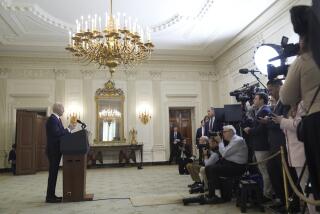Old Demons at Bay : U.S. Newspapers Face Future With New Confidence
SAN FRANCISCO — James Batten, president of Knight-Ridder Newspapers, was trying to tell investment analysts what his company learned from its failed experiment in videotext, the art of publishing news on video monitors rather than newsprint.
Last month, having lost $50 million in 2 1/2 years, Knight-Ridder scrapped its videotext division after finding no market for it.
“What did we learn?” Batten asked, about to answer his own question: “Sometimes pioneers get rewarded with arrows in the back.”
Frankly, most newspaper executives couldn’t be more pleased. Videotext--which many argued would soon make newspapers obsolete--is only one of many demons dreaded by newspaper owners a few years ago that now seem at bay.
Television networks, once threatening to grab the advertising market from big newspapers, now have troubles of their own. Last year’s merger frenzy, which led most newspaper companies to rush to their battlements, ended without a single publicly owned newspaper company succumbing.
For now, the American newspaper industry foresees a longer and brighter future than it not long ago supposed possible. The industry’s primary concern is how to rein in costs in what seems an uneven economy.
“We’re back to business again,” said John Reidy, an analyst with the brokerage firm of Drexel Burnham Lambert.
That is not to say that newspaper executives no longer see demons. Many companies are trying hard to focus again on their core operations, shedding experimental divisions that gave them a scare over the last few years.
For most, the message was summarized in an address at the American Newspaper Publishers Assn. annual meeting last week by Tom Johnson, outgoing president of the Newspaper Advertising Bureau and publisher of the Los Angeles Times:
“If we look at our business in the short term, we would seem to have few if any real problems.”
It did not always seem that way. Five years ago, Knight-Ridder, Dow Jones and Times Mirror, publisher of the Los Angeles Times and other newspapers, all began to explore videotext, fearful that computers and instant access to information could make newspapers obsolete.
Advertising Market Share Stable
Dow Jones has since shifted to selling databases to owners of personal computers. Times Mirror and Knight-Ridder both shut down their experiments earlier this year.
Another key worry a few years ago was television. In 1980, daily newspapers attracted roughly 27% of all advertising to television’s 21%, and the gap was narrowing. Since then, the proliferation of cable and local channels has fractionalized television, reducing the audience of the three networks. Today, newspapers still attract roughly 27% of the advertising market.
Newspapers kept their share, too, by competing better against direct-mail and free “shopper” publications, their fastest-growing rivals. A Newspaper Advertising Bureau poll released last week suggests that perhaps 78% of newspapers now offer such free publications themselves.
And the merger scare, which led many companies to institute anti-takeover measures last year, has apparently passed with the major newspaper companies intact. In the process, companies such as Knight-Ridder and Times Mirror spent millions to buy back their own shares, thereby increasing the amount of stock in friendly hands.
Others, such as Gannett Co. and New York Times Co., made several acquisitions, thereby increasing the size of their companies and swelling their debt.
With their past demons subdued, newspaper executives now seem most concerned with how to maintain steady profits.
The Newspaper Advertising Bureau forecasts that newspaper advertising revenue will grow 10% this year, a modest gain that could amount to perhaps a 6% increase after accounting for inflation.
But much of that growth could come late in the year. Most companies are “expecting fairly modest performance through summer” and then hoping for a big Christmas, said John Morton, a newspaper analyst with the brokerage firm of Lynch, Jones & Ryan.
And such predictions are more difficult because the strength of the economy differs markedly by region.
“We have a new ‘Sun Belt’: Boston, New York, Philadelphia, and Washington,” Reidy said. “And the old Sun Belt--Miami, Dallas, Denver and Los Angeles--(has) become the new Rust Belt.”
Indeed, papers in the Northeast are thriving while such papers as the Miami Herald, Dallas Morning News, Dallas Times Herald, Denver Post and Rocky Mountain News are suffering.
Some of the Sun Belt problems are due to the drop in oil prices. Yet national papers, such as the Wall Street Journal and USA Today, also report that advertising is down in areas of traditional growth such as computers.
To manage in this economy, most newspaper companies are restraining costs. Wall Street Journal publisher Dow Jones, for instance, has frozen both new and replacement hiring and today has almost 200 fewer employees than a year ago. This freeze follows a rapid expansion in 1984.
The Los Angeles Times is similarly trying to restrain costs, deferring some programs, stretching out others and delaying some hiring.
And several companies are focusing on “businesses they know and do the best,” Reidy said.
Dow Jones, for instance, sold off its cable television ventures, as did Tribune Co., which turned instead to buying more VHF television stations, a business that it has been in for decades. Times Mirror has sold off in recent years such operations as its microwave unit and parts of its book publishing and forest products units.
More to Read
Inside the business of entertainment
The Wide Shot brings you news, analysis and insights on everything from streaming wars to production — and what it all means for the future.
You may occasionally receive promotional content from the Los Angeles Times.










